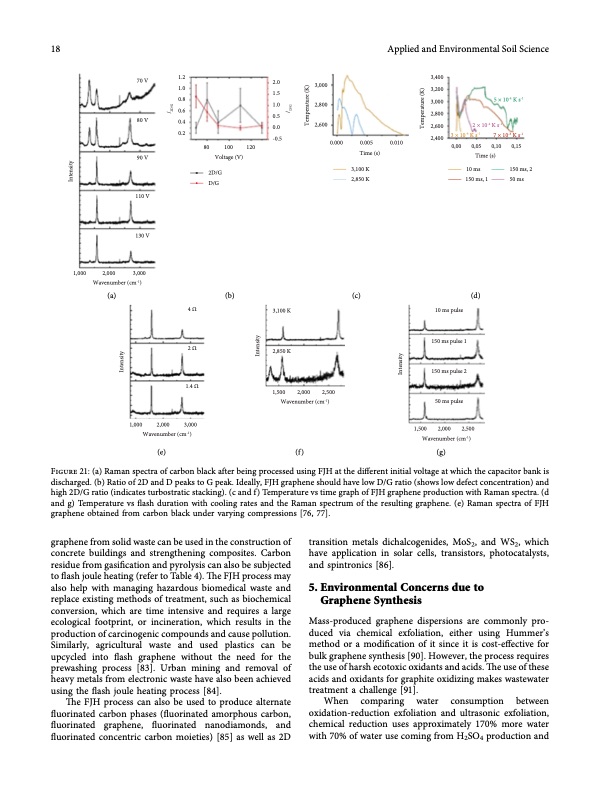
PDF Publication Title:
Text from PDF Page: 018
18 Applied and Environmental Soil Science 1,000 2,000 Wavenumber (cm-1) (a) 70 V 80 V 90 V 110 V 130 V 1.2 1.0 0.8 0.6 0.4 0.2 2.0 1.5 1.0 0.5 0.0 -0.5 3,000 2,800 2,600 3,400 3,200 3,000 2,800 2,600 2,400 5 × 10-4 K s-1 3,000 2,000 Wavenumber (cm-1) (e) graphene from solid waste can be used in the construction of concrete buildings and strengthening composites. Carbon residue from gasifcation and pyrolysis can also be subjected to fash joule heating (refer to Table 4). Te FJH process may also help with managing hazardous biomedical waste and replace existing methods of treatment, such as biochemical conversion, which are time intensive and requires a large ecological footprint, or incineration, which results in the production of carcinogenic compounds and cause pollution. Similarly, agricultural waste and used plastics can be upcycled into fash graphene without the need for the prewashing process [83]. Urban mining and removal of heavy metals from electronic waste have also been achieved using the fash joule heating process [84]. Te FJH process can also be used to produce alternate fuorinated carbon phases (fuorinated amorphous carbon, fuorinated graphene, fuorinated nanodiamonds, and fuorinated concentric carbon moieties) [85] as well as 2D transition metals dichalcogenides, MoS2, and WS2, which have application in solar cells, transistors, photocatalysts, and spintronics [86]. . Environmental Concerns due to Graphene Synthesis Mass-produced graphene dispersions are commonly pro- duced via chemical exfoliation, either using Hummer’s method or a modifcation of it since it is cost-efective for bulk graphene synthesis [90]. However, the process requires the use of harsh ecotoxic oxidants and acids. Te use of these acids and oxidants for graphite oxidizing makes wastewater treatment a challenge [91]. When comparing water consumption between oxidation-reduction exfoliation and ultrasonic exfoliation, chemical reduction uses approximately 170% more water with 70% of water use coming from H2SO4 production and 4Ω 2Ω 1.4 Ω 3,100 K 2,850 K 1,500 Wavenumber (cm-1) (f) 10 ms pulse 150 ms pulse 1 150 ms pulse 2 50 ms pulse 3,000 1,500 Wavenumber (cm-1) (g) 80 100 120 Voltage (V) 0.000 0.005 Time (s) 3,100 K 2,850 K (c) 0.010 0,00 0,05 0,10 Time (s) 10 ms 150 ms, 1 (d) K s-1 0,15 150 ms, 2 50 ms 2D/G D/G (b) 2,000 2,500 1,000 Figure 21: (a) Raman spectra of carbon black after being processed using FJH at the diferent initial voltage at which the capacitor bank is discharged. (b) Ratio of 2D and D peaks to G peak. Ideally, FJH graphene should have low D/G ratio (shows low defect concentration) and high 2D/G ratio (indicates turbostratic stacking). (c and f) Temperature vs time graph of FJH graphene production with Raman spectra. (d and g) Temperature vs fash duration with cooling rates and the Raman spectrum of the resulting graphene. (e) Raman spectra of FJH graphene obtained from carbon black under varying compressions [76, 77]. 2 × 10-4 K s-1 3 × 10-4 K s-1 7 × 10-3 2,000 2,500 Intensity Intensity Intensity / 2D/G / D/G Temperature (K) Intensity Temperature (K)PDF Image | State-of-the-Art Graphene Synthesis Methods

PDF Search Title:
State-of-the-Art Graphene Synthesis MethodsOriginal File Name Searched:
8475504.pdfDIY PDF Search: Google It | Yahoo | Bing
Salgenx Redox Flow Battery Technology: Power up your energy storage game with Salgenx Salt Water Battery. With its advanced technology, the flow battery provides reliable, scalable, and sustainable energy storage for utility-scale projects. Upgrade to a Salgenx flow battery today and take control of your energy future.
| CONTACT TEL: 608-238-6001 Email: greg@infinityturbine.com | RSS | AMP |